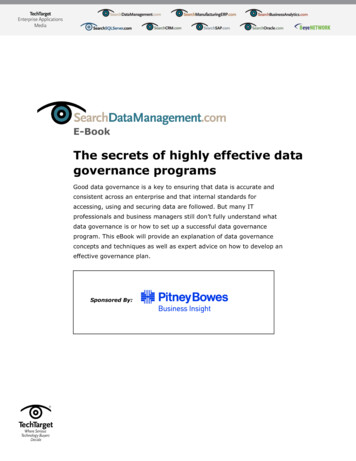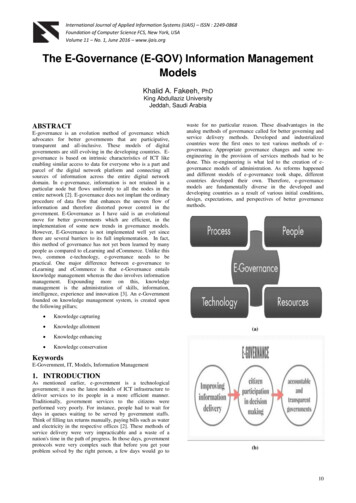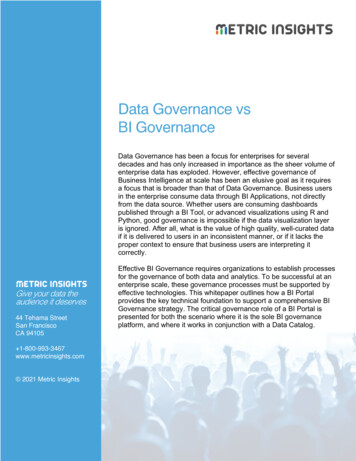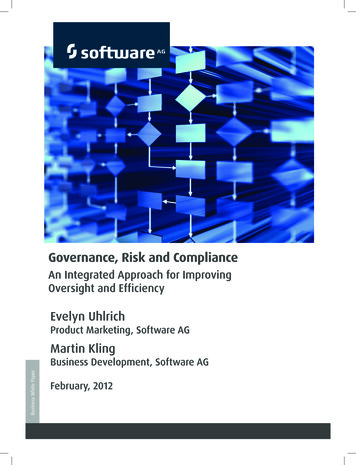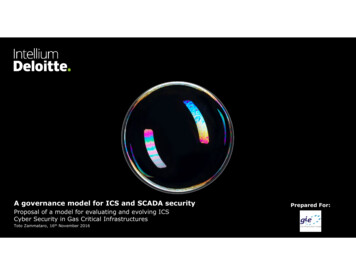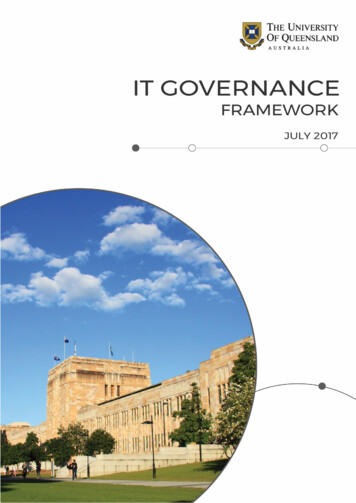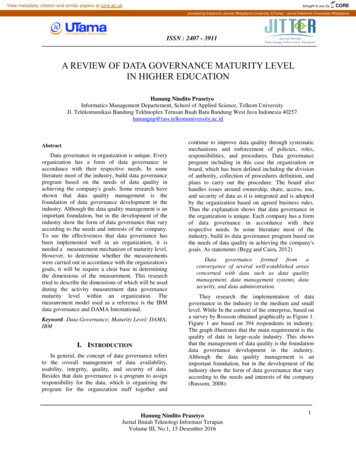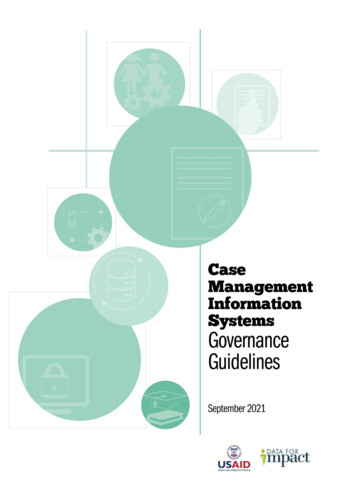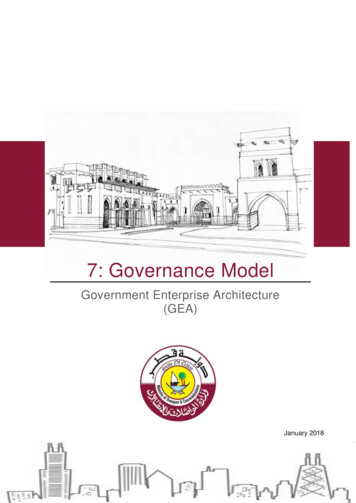
Transcription
7: Governance ModelGovernment Enterprise Architecture(GEA)January 2018MoTC Confidential - Draft Governance Model1
Government Enterprise ArchitectureTable of Contents1Introduction . 52Document Structure . 53Government Enterprise Architecture (GEA) Governance Framework. 63.13.24Upstream Governance . 7Downstream Governance . 8GEA Governance Model. 94.1GEA Governance Structure . 94.1.1Structure & Roles . 94.1.25Governance Processes . 11Enabling Policies . 125.1Overall GEA adoption . 125.2Business Architecture . 135.2.1Investment planning and control . 135.3Information Architecture . 135.3.1Data management policy . 135.3.2Smart Qatar data standards . 145.3.3Open data policy . 145.4Application Architecture . 145.4.1Service development lifecycle . 145.4.2Government website and eservices framework. 155.4.3Government Mobile Services Framework . 155.4.4E-Participation policy . 155.4.5E-Accessibility Policy . 165.5Infrastructure architecture . 175.5.1Council of Ministers’ Resolution No. (18) of 2010 on the implementation of e-governmentpolicies175.5.2Cloud security policy . 175.5.3Bring Your Own Device (BYOD) policy . 175.6Security management . 185.6.1National Information Assurance (NIA) policy . 185.6.2Smart Qatar information security standards . 195.6.3Cloud security policy . 195.6.4BYOD policy . 196Appendix 1 – GEA Compliance self-assessment template . 207Appendix 2 – Enterprise Architecture Maturity Model for Qatar . 247.1Maturity levels & EA measurement characteristics . 24Governance Model2
Government Enterprise Architecture7.1.1Maturity Level 0 - No Enterprise Architecture in place . 257.1.2Maturity Level 1 – Initial – Informal EA process underway . 257.1.3Maturity Level 2 – Under Development . 257.1.4Maturity Level 3 - Defined Enterprise Architecture . 257.1.5Maturity Level 4 - Managed and Measured Enterprise Architecture Process . 267.1.6Maturity Level 5 - Continuous Improvement of Enterprise Architecture Process . 268Appendix 3 – Tooling support . 289Appendix 4 – GEA compliance statement for ICT tenders . 2910Glossary. 30Governance Model3
Government Enterprise ArchitectureTable of FiguresFigure 1 - GEA Governance . 7Figure 2 - Governance bodies . 11TablesTable 1 - Structure & Roles . 9Governance Model4
Government Enterprise Architecture1 IntroductionThis document provides the Governance model for Qatar Government Enterprise Architecture(GEA). It describes enabling policies, governance framework, team structure, and associatedprocesses to be established for effective adoption and sustained governance of GEA. The modelcovers both the Enterprise Architecture governance (upstream) as well as individual solutionarchitecture governance (downstream) to deliver solutions that meet the needs of the businessand is in alignment with the Enterprise Architecture.2 Document StructureGEA Governance model document is structured as described below. GEA Governance overview – provides a high-level overview of GEA Governance framework explainingboth Upstream governance focusing on ‘doing the right things’ and Downstream governance focusing on‘doing things right’ GEA Governance model - describes the Governance model elements, structure & roles and theestablished processes for effective governance of GEA Enabling policies - define what the agencies need to adopt, develop, maintain, and facilitate for theimplementation of a sound and integrated information technology architecture that is consistent andcompliant with Government Enterprise Architecture (GEA) Appendix 1 – GEA Compliance Self-Assessment template – provides a template for agencies to performGEA compliance self-assessment Appendix 2 – Maturity model – captures the Enterprise Architecture Maturity Model for Qatar Appendix 3 – Tooling support - highlights the tooling support available for adoption of GEA referencemodels Appendix 4 – GEA compliance statement for ICT tenders – specifies the statement to be included in ICTtenders issued and managed by individual government agencies Glossary – lists all the Acronyms used in the document and their expansions.Governance Model5
Government Enterprise Architecture3 Government Enterprise Architecture (GEA) GovernanceFrameworkArchitecture governance involves a synergy of the right structures, processes, and people. Itsoperation is very much dependent upon the culture of an organisation and requires time toestablish. It is the capability that ensures that the architecture is properly enacted in businessand architecture initiatives, and retains its relevance and effectiveness in the organisation. Thepurpose of the enterprise architecture is to facilitate development of an ICT and technologyinfrastructure that supports business direction. Hence, governance can be seen as a capabilitynecessary to ensure that initiatives are enacted in such a way that is consistent with the businessdirection.GEA Governance is critical to ensure that GEA Reference Models are relevant, actively used,and maintained to provide sustainable value.The following diagram (Figure 1 - GEA Governance) illustrates the positioning of GEAGovernance within the context of strategic plan, which identifies the direction of the Governmentand follows the strategic intent, and the GEA Reference Models , which identifies the end statearchitectural views for the government agencies (business, information, application, andinfrastructure). Programmes and projects are driven from the strategic plan and manifest asstrategic initiatives. GEA Governance plays a role in ensuring that systems coming out of thestrategic initiatives are designed in accordance with the enterprise architecture reference modelsand guidance.Governance Model6
Government Enterprise ArchitectureFigure 1 - GEA GovernanceThis model is explained below to show to two major functions of GEA Governance.3.1 Upstream GovernanceEnsuring the Government is identifying, funding & resourcing the most important programmes,in line with the digital transformation strategy - “Doing the right things”Government services and new initiatives need to align with the strategic plan (and intent) of theQatar government to ensure that existing / new government services are consistent with thestrategic direction. That is, does the service or solution meet (or follow) the strategic goals of thegovernment?Key GEA artefacts that represent/align with the strategic goals/direction of the Qatar governmentand include: Business Reference Model (BRM) Information Reference Model (IRM) Application Reference Model (ARM) Infrastructure (Technology) Reference Model (TRM)Governance Model7
Government Enterprise ArchitectureThe Business reference model is leveraged prior to, and during, the Discovery phase of theService Creation Method as a means of ensuring that newly identified services align with thestrategic goals of the government.Application and Infrastructure Reference models areanalysed to avoid duplicate efforts and also to identify reuse or consolidation opportunities.Information Reference model provides an authoritative source of information assets owned bythe government agencies to facilitate cross-agency collaborative efforts.Typically, the IT Department of Government Agencies along with their business units willestablish the need for new ICT services, determine the project scope and secure the fundingapproval from its Agency or relevant authorities. Upon its internal funding approval, governmentagencies would draft and issue their ICT Tender Specifications for the final selection and awardof the tender. Such ICT procurements, if left un-coordinated, will lead to much duplications andwaste of government resources.To ensure maximum benefit, the Government of Qatar has determined that such ICTprocurements of systems and services shall also be consistent with and supportive of nationalICT initiatives including the Qatar National ICT Plan 2015 and the eGov2020 strategy. Throughleveraging common Government-wide systems and shared services, productivity and efficiencycan be improved and duplicate efforts are avoided. To this effect, all government agencies arerequired to follow ICT procurement review policy specified in IT procurement policy document.They can use the BRM to demonstrate the project’s alignment with Qatar Government strategyand their use of shared services.GEA artefacts must also be maintained to ensure they are aligned with any changes to thegovernment strategy and helps guide projects to deliver services in accordance with governmentstrategy.3.2 Downstream GovernanceEnsuring these programmes are delivering solutions that meet the needs of the business andwork within the existing environment - “Doing things right”The GEA artefacts also serve a purpose on the downstream by providing technical control andguidance over the design of services and solutions to ensure that services/solutions aredesigned and developed in a consistent manner and using common platforms, technology, andother standards.Key GEA artefacts that assist in downstream governance include: Qatar government prescribed policies and standards Reference Architectures (Business, Application, Information Exchange, Infrastructure)Governance Model8
Government Enterprise Architecture Next-gen Service Delivery Method (aka Service Creation Method)Design Authorities and the next-gen Delivery Method service checkpoints serve as mechanismto enforce compliance with the enterprise architecture.4 GEA Governance Model4.1 GEA Governance Structure4.1.1 Structure & RolesThe main bodies engaged with the actual governance are identified in the table below. The keyparticipants in each body and their responsibilities is also captured in the table.Table 1 - Structure & RolesGovernanceBodyKey ParticipantsKey FocusICT GovernanceBoardMoTC, other keyStrategic Focus -- A business-wide ITSteering or Strategy committee which isconcerned with the overall strategic ICTdirection for the Qatar Government.government entities(Qatar DigitalGovernmentSteeringCommittee)This body has a whole of governmentfocus.Typical Responsibilities: ArchitectureReview Board(WoG Level)The ARB will comprise: WoG ArchitectureSponsor WoG EnterpriseArchitecture Focus -- The primary focusis on the Qatar Government enterprisearchitecture and platform: ensuring itremains current, relevant, and properlyinfluences solution structure.This body also has a predominantly wholeof government focus.Architect Provides strategic ICT directionDetermines ICT business prioritiesDetermines scope of governanceAuthorizes High impact exceptionsOther (invited)members as requiredTypical Responsibilities: Overall responsibility for the entire GEAacross the whole of government. This ismaintained through the Office of theChief ArchitectAuthorizes Medium impact exceptionsGovernance Model9
Government Enterprise Architecture Technical ReviewBoard(Agency Level)For Each Agency: Architecture Sponsor Agency nominatedEnterprise Architect Escalation point for appeals and disputesregarding complianceCompliance Focus -- The primary focusis to ensure that solution t services – especially sharedservices) conform to the enterprisearchitecture and the principles.Other (invited)members as required(e.g. Project teamrepresentatives,integration team,security, etc )This body is responsible for enforcingcompliance and/or exceptions (if deemedappropriate) to the enterprise architecture.The next-gen delivery method andcheckpoints are one mechanism helping toachieve this.Typical Responsibilities: DesignAuthorities(Project Level) Project management Lead Architect onProgramme/ProjectDelivery Assesses and authorizes compliance ofsolutions with government enterprisearchitectureAuthorizes Low impact exceptionsSolution Focus -- Solution -design process followed forService Design (e.g. Service CreationMethod) is aligned to the enterprisearchitecture.Other nominatedmembers on the teamThis body is focused on specific solutionswithin a project.Typical Responsibilities: Derive solutions that comply with thearchitectureUses architecture to meet project needsDescription of key participants to the GEA governance process is provided below. WoG Architecture Sponsor: The MoTC Assistant Undersecretary of Government IT Sector is the owner ofGovernment Enterprise Architecture and ensures alignment to national strategies and objectives.WoG Enterprise Architect: MoTC nominated Enterprise Architect managing WoG EA models shall beexpected to fulfil this role. He/she may be supported by assigned domain experts such as informationarchitect, application architect etc.Agency Architecture Sponsor: Executive sponsor for the Enterprise architecture initiative within theAgency. Typically, it could be CIO of the agency or a senior level Executive.Agency Enterprise Architect: Person responsible for producing and managing architectural models at theagency level.Governance Model10
Government Enterprise Architecture Agency Project Management: The project manager ensures that project level compliance process to GEAis adhered to and manages upstream communication with relevant authorities as required.Agency Project Lead Architect: The lead architect performs project’s compliance assessment to GEA. Hisor her role also includes designing the solution that is at all times compliant to the GEA models andstandards, and reporting any unavoidable exceptions to the project management. This role can also befulfilled by vendor’s lead/solution architect and hence a statement provided in Appendix 4 of thisdocument should be included of each ICT tender of government agencies.4.1.2 Governance ProcessesThe following diagram further elaborates on the governance bodies and their interactions androles.Figure 2 - Governance bodiesEach body has distinct roles and a unique focus as indicated in the diagram. The ArchitectureReview Board is a cross-organisational body (i.e. WoG) and MoTC plays a leading role in ARB.Representatives from other government entities/agencies may also be nominated as temporarymembers. IT Procurement Review Committee may request ARB’s opinion in case of architecturerelated exceptions at project level. Technical Review Board is setup at agency level focusing oncompliance of agency developed architectures – both Enterprise Architecture and solutionarchitectures - with GEA. They will leverage the self-assessment templates defined in Appendix1 for compliance assessment and reporting. Design Authorities are associated with specificsolutions and would generally be comprised of representatives from the agencies delivering thesolution/service.Governance Model11
Government Enterprise Architecture5 Enabling PoliciesThe policies outlined in this section govern the planning, adoption and implementation ofEnterprise architecture at agencies. Agencies are expected to comply with the policies definedbelow. Any clarification on policies can be directed to policyfeedback@motc.gov.qa emailaddress. They are grouped under the following categories.1.Overall GEA adoption2.Business Architecture3.Information Architecture4.Application Architecture5.Infrastructure Architecture6.Security managementApart from the policies listed in this section, agencies should refer to individual reference modeldocumentation for prescribed standards and controls and comply.5.1 Overall GEA adoption1.Agencies shall identify and nominate an executive sponsor for the Enterprise Architecture program withinthe agency – e.g.: CIO or other senior executive.2.Agencies shall nominate an enterprise architect to manage EA within the agency who will perform belowtasks. The enterprise architect may also be supported by nominated business, information, application,infrastructure architects as may be required.a.Periodically or as requested by MoTC, assess and report GEA compliance based on questionnaireprovided in Appendix 1.b.3.Create a plan for adopting the GEA reference models and standards .Agencies shall establish a Technical Review Board with in the agency to focus on GEA compliance asdefined in the Governance model structure.4.Agencies shall publish to MoTC, the required Enterprise Architecture artefacts aligned to the GEAreference model taxonomies on a periodic basis– i.e. Catalogues and matrices aligned to PRM, BRM, IRM,ARM, TRM taxonomies.5.Agencies shall plan for adopting an EA tooling which is based on Archimate 3.0 standard.6.Agencies shall ensure project level compliance to GEA reference models and standards and includestatement provided in Appendix 4 of this document, in each of their ICT tenders.Governance Model12
Government Enterprise Architecture5.2 Business Architecture5.2.1 Investment planning and control1.Investment decisions shall be made in accordance with national as well as agency’s vision and strategicplan.2.For all new IT investments, agencies shall adequately demonstrate alignment with Government EnterpriseArchitecture reference models: Business – Performance management, Information, Application, andTechnical.3.Measurable KPIs shall be identified to track the performance of any new business service against statedgoals in the investment request.5.3 Information Architecture5.3.1 Data management policyAgencies shall ensure compliance with the Data Management Policy that aims at establishingthe governance and standard processes across the Government Agencies in the State of Qatarfor managing and sharing data. It defines clear duties and responsibilities for all who managepublic sector information. The policy includes key provisions on Data Governance, DataAdministration, Data Protection, and Data Sharing. It should be noted that this policy operatessubject to privacy, copyright, legal and security considerations.Please refer to the following document for more details.English nt/data-management-policyArabic /sys dr lbynt.pdfGovernance Model13
Government Enterprise Architecture5.3.2 Smart Qatar data standardsAgencies delivering Smart Services (Refer TASMU website for details) shall adopt the SmartQatar Data Standards controls that have been defined across nine technical and governancedomains to ensure effective data management across the data lifecycle. People and processconsiderations for data management have also been embedded across the defined controls.Adopting these data standards will help achieve national orchestration for data interoperabilitythereby enabling attainment of Smart Qatar objectives (Refer TASMU website for details). Theyfacilitate the creation, storage, movement, usage, and sharing of data by establishing anunderstanding of how data should be uniformly described, represented, seamlessly and securelydelivered and in the form stakeholders expect for conducting analysis, extracting insights, andmaking decisions. Please refer to latest version of Smart Qatar Data Standards document formore details on controls defined across the nine domains as per the Smart Qatar DataManagement Framework.5.3.3 Open data policyAgencies shall adopt Open Data policy aims to ensure that all government agencies take stepsto expand public access to government data by making it available online unless restricted bylaw, policy, regulations or contract. The policy applies to information and data in the custody orunder the control of all government agencies in Qatar.Please refer to the following document for more details.English /open data policy 0.pdfArabic /sys lbynt lmftwh 0.pdf5.4 Application Architecture5.4.1 Service development lifecycle1.Agencies shall establish a Design Authority for new solution development initiatives.An AgencyEnterprise Architect will be part of the Design Authority.2.Agencies Design Authority shall participate in the checkpoint reviews conducted by the Technical ReviewBoard at various stages defined as part of the Service delivery method – Discovery, Alpha, Beta, and Live.3.Design Authority shall demonstrate alignment to GEA, shared services leveraged, cross-agencyinformation assets leveraged, and compliance to standards during the checkpoint reviews.4.Any exceptions required shall be raised by Design Authority to the Technical Review Board and will beprocessed as per the defined governance process.Governance Model14
Government Enterprise Architecture5.4.2 Government website and eservices frameworkThe websites and online services of each Government Agency carries their own unique designs,layouts, interfaces and navigation architecture. This different “look and feel” can be confusingand difficult for the public as they would have to re-orientate themselves when they visit eachgovernment website. Standardization and uniformity is needed to ensure that governmentagencies’ websites and services are public centric and user friendly.In order to ensure that government websites are easy for the public to access and provide amore consistent experience when navigating across different government websites, theGovernment Website and e-Services Framework has been developed to define a set of bothstandards and best practice guidelines for the overall design of government websites and eServices.Agencies are required to follow the guidelines specified in the ‘Government Website and eServices Framework’ document by following this link.English c /tr m llmwq wlkhdmt llktrwny lljht lhkwmy lsdr lthny.pdf5.4.3 Government Mobile Services FrameworkGovernment Mobile Services Framework document has been prepared to assist Governmentagencies in the design and deployment of mobile services based on international best practicesand standards. Please refer to the guidelines and standards provided in the document – linkto be updated with URL to the published document location 5.4.4 E-Participation policyThe e-Participation Policy aims at instituting the culture and practices of e-participation acrossGovernment Agencies and improving transparency and people’s participation, therebyassisting the State of Qatar in achieving its national development goals.Governance Model15
Government Enterprise ArchitectureThe Government of the State of Qatar has always recognized the value of engaging the peoplein governance processes. Qatar’s National Development Strategy 2011-2016 acknowledgesthat people are a country’s most valuable asset and their participation in political, social andeconomic spheres will contribute to sustaining a prosperous society. Engagement with theirpeople allows governments to tap into wider perspectives, sources of information, and potentialsolutions to improve decisions and services. It also provides the basis for productiverelationships, improved dialogue and deliberation, and ultimately, better governance. Theobjective of e-Participation is to engage people in development policy and decision-makingprocesses through use of information and communication technologies.For more details on this policy, please refer to:English /e-participation policy 1.pdfArabic /sys lmshrk llktrwny 0.pdf5.4.5 E-Accessibility PolicyE-Accessibility policy aims to ensure people with disabilities in Qatar have equal access to thetechnologies that can enrich their lives, and covers a range of e-Accessibility issues, includingwebsites, telecommunications services, handsets, ATMs, government services, access toassistive technologies and digital content. This policy should be adopted while designing nextgeneration digital services for Qatar Government.For more details on this policy, please refer to:English /qatar eaccessibility policy en - ictqatar 0.pdfArabic /qatars eaccessibility policy ar - ictqatar 0.pdfGovernance Model16
Government Enterprise Architecture5.5 Infrastructure architecture5.5.1 Council of Ministers’ Resolution No. (18) of 2010 on the implementation of egovernment policiesThe Resolution requires government entities to implement policies and reuse shared servicesand infrastructure developed by the Ministry of Transport and Communications including but notlimited to government reference architecture and standards, authentication platform, paymentplatform, data centre, government network, contact centre, PKI etc. Please refer to followinglinks for more details:English /council of ministers resolution no. 18 of 2010 onthe implementation of e-government policies 0.pdfArabic /qrr mjls lwzr rqm 18 lsn 2010 bshn tnfydh syst lhkwm llktrwny.pdf5.5.2 Cloud security policyThe purpose of this policy is to provide government agencies with an overview of cloudcomputing and the security and privacy challenges involved. The document discusses thethreats, technology risks, and safeguards for cloud environments, and aspires to provide theinsight needed to make ICT decision makers take informed decisions by providing tools such asa detailed questionnaire that can be used to assess and evaluate the cloud service provider(CSP) offerings.For more details on this policy, please refer to:English /cloud security policy for government agencies 2014 0.pdfArabic /sys tmyn lhwsb lshby llmwsst lhkwmy 2014 0.pdf5.5.3 Bring Your Own Device (BYOD) policyThis policy expects to set the tone and expectations
The model covers both the Enterprise Architecture governance (upstream) as well as individual solution architecture governance (downstream) to deliver solutions that meet the needs of the business and is in alignment with the Enterprise Architecture. 2Document Structure GEA Governance model document is structured as described below.
